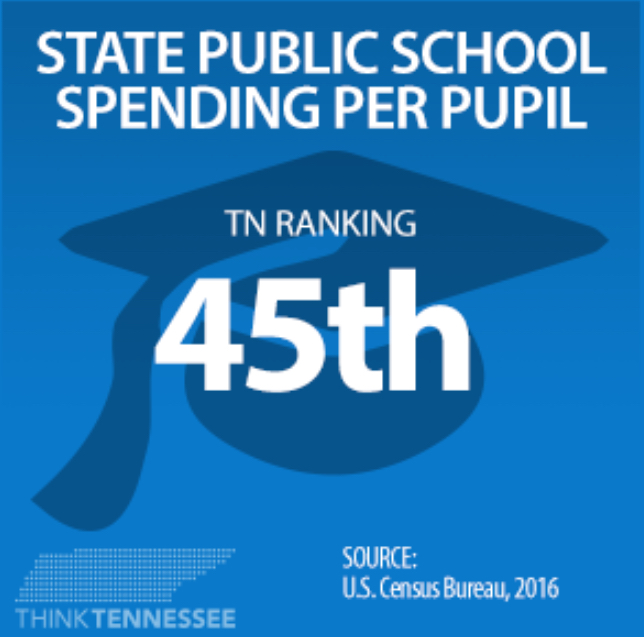Is the BEP fully funded? Bill Lee wants you to think so. A recent Tennessean story calls this issue into question, however. Taking into account the reality of the BEP is more complicated, but the bottom line answer is this: No, Bill Lee’s budget does NOT fully fund the BEP and he and his staff should know better.
The Tennessean points out that despite new investments from Governor Haslam and now Governor Lee, educators are not happy with the adequacy of the state’s funding formula.
There is good reason to be concerned. For example, Tennessee is now investing less per pupil than we did in 2010:
To translate, in 2010 (the year before Bill Haslam became Governor), Tennessee spent an average of $8877 per student in 2016 dollars. In 2016 (the most recent data cited), that total was $8810. So, we’re effectively spending slightly less per student now than in 2010. The graph indicates that Tennessee spending per student isn’t really growing, instead it is stagnating.
It’s also worth noting that our teacher salary increases aren’t matching national averages:
Average teacher salaries in the United States improved by about 4% from the Haslam Promise until this year. Average teacher salaries in Tennessee improved by just under 2% over the same time period. So, since Bill Haslam promised teachers we’d be the fastest improving in teacher pay, we’ve actually been improving at a rate that’s half the national average. No, we’re not the slowest improving state in teacher pay, but we’re also not even improving at the average rate.
By contrast, states like California and North Carolina have seen increases of over 9% over the same time period, making them the two fastest improving states. Vermont is close behind at just over a 7% total increase.
While talking about teacher salaries, it’s important to note the BEP does NOT fully fund teacher pay and in fact, funds a level far below the actual average cost of hiring a teacher:
As for teacher compensation, the state pays 70% of the BEP calculated rate — which is now $46,225. The good news: That calculated rate has been increasing in recent years. The bad news: That rate is still $7000 LESS than the average teacher compensation paid by districts in the state.
What does this mean? It means districts have to make up a big difference in order to maintain their level of pay. As one example, Nashville is struggling to pay teachers on par with similar cities nationally. Based on current BEP formula allocations, funding teaching positions at the actual average rate would mean MNPS would receive an additional $21 million for teacher compensation. Those funds would certainly help close the pay gap that plagues the system.
Then, of course, there are unfunded or underfunded mandates. One example, RTI – Response to Intervention:
One possible solution would be to embed funding for school-level RTI2 specialists in the state’s funding formula for schools, the BEP. In fact, Rep. Joe Pitts offered legislation that would do just that last year. His plan would have added funding for three RTI2 specialists at each school for a total projected cost of $167 million. Commissioner McQueen was quick to shoot that idea down and came back this year with the funding proposal of $13 million, or one specialist per district. That’s only $154 million short of adopting a plan that would actually meet the needs of a program many suggest is an important way to improve educational outcomes for Tennessee students.
Our own Comptroller, a Republican, also indicates the state is significantly behind where it should be to adequately fund the BEP:
The Comptroller’s Office of Research and Education Accountability is out with a new report that suggests Tennessee is underfunding its schools by at least $400 million. That’s because the BEP (the state’s funding formula for schools) fails to adequately fund education personnel.
Finally, it’s worth noting that Bill Haslam created a fake BEP task force designed to let him out of the responsibility to adequately fund schools and then effectively froze BEP 2.0. In that sense, it’s actually inaccurate to say our state is “fully funding” the BEP. In fact, we’re funding “growth only” in a frozen formula. Facts matter. History is difficult, I know. But those talking about this issue would do well to cite the recent history in their reporting.
Enter Governor Bill Haslam. He appointed his own BEP Task Force independent of the statutorily mandated BEP Review Committee. At the time, I speculated this was because he didn’t like the Review Committee’s recommendations and its insistence that the state was at least $500 million behind where it should be in education funding.
Now, he’s proposing a “BEP Enhancement Act.” This so-called enhancement is sailing through the General Assembly. It is seen as the most likely vehicle to get money to rural districts and in a year when education funds are increasing, why sweat the details?
As I’ve written before, a few districts lose significantly in the move because it eliminates the Cost Differential Factor (CDF).
It also freezes BEP 2.o. Gone are the dreams of full funding of this formula. The law makes permanent the 70% state funding of BEP-generated teaching positions and funds teacher salaries at a rate well below the state average salary.
Someone should tell Bill Lee and legislative leadership about this. They keep going around repeating the lie that the BEP is “fully funded.” The truth is quite different. I suspect Lee’s staffers know the reality, and are just not telling him. Alternatively, they don’t know the facts — in which case, they don’t deserve their jobs.

For more on education politics and policy in Tennessee, follow @TNEdReport
Your support — either a one-time or ongoing gift — makes reporting education news sustainable.






